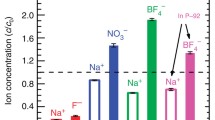Abstract
We present a conceptual framework for understanding and formulating ion transport in concentrated solutions, which pictures the ion transport as an ion-vacancy coupled charge transfer reaction. A key element in this picture is that the transport of an ion from an occupied to unoccupied site involves a transition state which exerts double volume exclusion. An ab initio random walk model is proposed to describe this process. Subsequent coarse-graining results in a continuum formula as a function of chemical potentials of the constituents, which are further derived from a lattice-gas model. The subtlety here is that what has been taken to be the chemical potential of the ion in the past is actually that of the ion-vacancy couple. By aid of this new concept, the driving force of ion transport is essentially the chemical affinity of the ion-vacancy coupled charge transfer reaction, which is a useful concept to unify transport and reaction, two fundamental processes in electrochemistry. This phenomenological model is parameterized for a specific material by the aid of first-principles calculations. Moreover, its extension to multiple-component systems is discussed.
Similar content being viewed by others
References
Richey FW, Dyatkin B, Gogotsi Y, Elabd YA. J Am Chem Soc, 2013, 135: 12818–12826
Simon P, Gogotsi Y. Acc Chem Res, 2013, 46: 1094–1103
Lee AA, Kondrat S, Kornyshev AA. Phys Rev Lett, 2014, 113: 048701
Kornyshev AA, Spohr E, Vorotyntsev MA. Electrochemical Interfaces: At the Border line. New York: Wiley, 2002
Bockris JO, Reddy AKN, Gamboa-Aldeco ME. Modern electrochemistry 2A. 2nd Ed. New York: Kluwer Academic Publishers, 2002
Lee AA, Colby RH, Kornyshev AA. Soft Matter, 2013, 9: 3767–3776
Lu W, Fadeev AG, Qi B, Smela E, Mattes BR, Ding J, Spinks GM, Mazurkiewicz J, Zhou D, Wallace GG, MacFarlane DR, Forsyth SA, Forsyth M. Science, 2002, 297: 983–987
Baughman RH, Cui C, Zakhidov AA, Iqbal Z, Barisci JN, Spinks GM, Wallace GG, Mazzoldi A, de Rossi D, Rinzler AG, Jaschinski O, Roth S, Kertesz M. Science, 1999, 284: 1340–1344
Wang X, Mehandzhiyski AY, Arstad B, Van Aken KL, Mathis TS, Gallegos A, Tian Z, Ren D, Sheridan E, Grimes BA, Jiang DE, Wu J, Gogotsi Y, Chen D. J Am Chem Soc, 2017, 139: 18681–18687
Fedorov MV, Kornyshev AA. Chem Rev, 2014, 114: 2978–3036
Van Aken KL, Beidaghi M, Gogotsi Y. Angew Chem Int Ed, 2015, 54: 4806–4809
Giordani V, Tozier D, Tan H, Burke CM, Gallant BM, Uddin J, Greer JR, McCloskey BD, Chase GV, Addison D. J Am Chem Soc, 2016, 138: 2656–2663
Gadzuric S, Suh C, Gaune-Escard M, Rajan K. Metall Mat Trans A, 2006, 37: 3411–3414
Zhao Y, Daemen LL. J Am Chem Soc, 2012, 134: 15042–15047
Liu Z, Fu W, Payzant EA, Yu X, Wu Z, Dudney NJ, Kiggans J, Hong K, Rondinone AJ, Liang C. J Am Chem Soc, 2013, 135: 975–978
Fan L, Wei S, Li S, Li Q, Lu Y. Adv Energy Mater, 2018, 8: 1702657
Cogswell DA, Bazant MZ. Nano Lett, 2013, 13: 3036–3041
Malik R, Zhou F, Ceder G. Nat Mater, 2011, 10: 587–590
Suo L, Borodin O, Gao T, Olguin M, Ho J, Fan X, Luo C, Wang C, Xu K. Science, 2015, 350: 938–943
Kilic MS, Bazant MZ, Ajdari A. Phys Rev E, 2007, 75: 021503
Zhao H. Phys Rev E, 2001, 84: 051504
Bazant MZ, Kilic MS, Storey BD, Ajdari A. Adv Colloid Interface Sci, 2009, 152: 48–88
Kornyshev AA. J Phys Chem B, 2007, 111: 5545–5557
Borukhov I, Andelman D, Orland H. Phys Rev Lett, 1997, 79: 435–438
Wang H, Thiele A, Pilon L. J Phys Chem C, 2013, 117: 18286–18297
Ferguson TR, Bazant MZ. J Electrochem Soc, 2012, 159: A1967–A1985
Lee AA, Kondrat S, Vella D, Goriely A. Phys Rev Lett, 2015, 115: 106101
Bikerman JJ. London Edinburgh Dublin Philos Mag J Sci, 1942, 33: 384–397
Riess I, Maier J. Phys Rev Lett, 2008, 100: 20590
Cahn JW, Hilliard JE. J Chem Phys, 1958, 28: 258–267
Braga MH, Ferreira JA, Stockhausen V, Oliveira JE, El-Azab A. J Mater Chem A, 2014, 2: 5470–5480
Ravikumar B, Mynam M, Rai B. J Phys Chem C, 2018, 122: 8173–8181
Maldonado-Manso P, Losilla ER, Martínez-Lara M, Aranda MAG, Bruque S, Mouahid FE, Zahir M. Chem Mater, 2003, 15: 1879–1885
Fu J. J Am Ceram Soc, 1997, 80: 1901–1903
Zhang Y, Zhao Y, Chen C. Phys Rev B, 2013, 87: 134303
Abbott AP, Harris RC, Ryder KS. J Phys Chem B, 2007, 111: 4910–4913
Zhou F, Cococcioni M, Marianetti CA, Morgan D, Ceder G. Phys Rev B, 2004, 70: 235121
Morgan D, van der ven A, Ceder G. Electrochem Solid-State Lett, 2004, 7: A30
Sun Y, Lu X, Xiao R, Li H, Huang X. Chem Mater, 2012, 24: 4693–4703
Islam MS, Driscoll DJ, Fisher CAJ, Slater PR. Chem Mater, 2005, 17: 5085–5092
Leonardi E, Angeli C. J Phys Chem B, 2010, 114: 151–164
Krishna R, Wesselingh JA. Chem Eng Sci, 1997, 52: 861–911
Krishna R, van Baten JM. Chem Eng Sci, 2009, 64: 3159–3178
Lee AA, Kondrat S, Oshanin G A, Kornyshev A. Nanotechnology, 2014, 25: 315401
Acknowledgements
This work was supported by the National Natural Science Foundation of China (21673163, 21832004, 21802170). J. Huang appreciates financial support from Central South University (502045001, 20180020050002).
Author information
Authors and Affiliations
Corresponding authors
Rights and permissions
About this article
Cite this article
Gao, Y., Huang, J., Liu, Y. et al. Ion-vacancy coupled charge transfer model for ion transport in concentrated solutions. Sci. China Chem. 62, 515–520 (2019). https://doi.org/10.1007/s11426-018-9423-8
Received:
Accepted:
Published:
Issue Date:
DOI: https://doi.org/10.1007/s11426-018-9423-8




